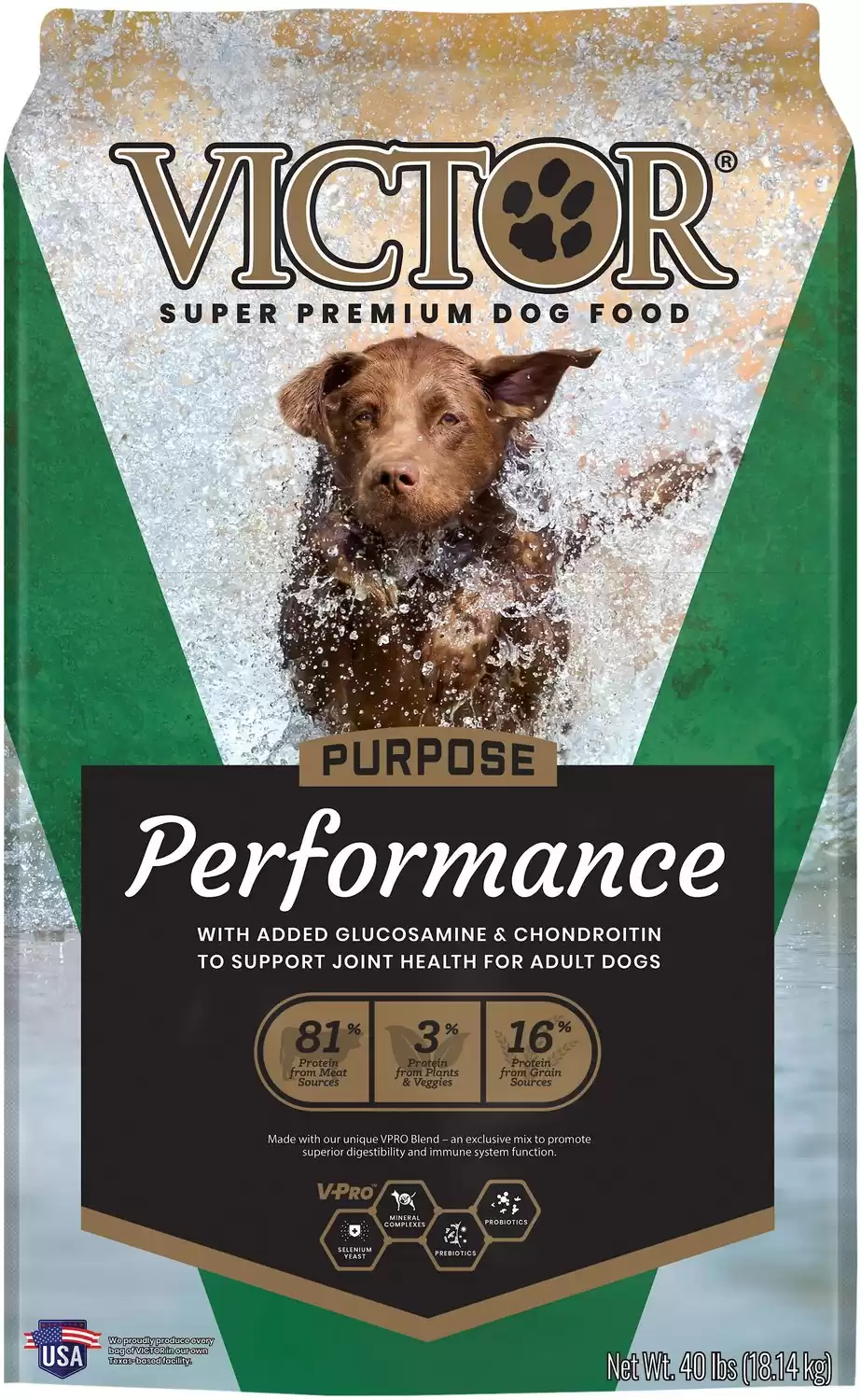Neapolitan Mastiff
Canis lupus
Neapolitan Mastiff dogs have a rather famous history, dating back to the Roman Empire and Julius Caesar.
Advertisement
Neapolitan Mastiff Scientific Classification
- Kingdom
- Animalia
- Phylum
- Chordata
- Class
- Mammalia
- Order
- Carnivora
- Family
- Canidae
- Genus
- Canis
- Scientific Name
- Canis lupus
Read our Complete Guide to Classification of Animals.
Neapolitan Mastiff Conservation Status
Neapolitan Mastiff Facts
- Fun Fact
- Neapolitan Mastiff dogs have a rather famous history, dating back to the Roman Empire and Julius Caesar.
- Diet
- Omnivore
- Common Name
- Neapolitan Mastiff
Neapolitan Mastiff as a Pet:
- General Health
- Energy Level
- Shedability
- Trainability
- Intelligence
- Tendency to Chew
- Size
- Family and kid friendliness
- Yappiness / Barking
- Low
- Separation Anxiety
- High
- Preferred Temperature
- Cold climate
- Exercise Needs
- Low
- Friendly With Other Dogs
- Moderate
- Pure bred cost to own
- $2,500 - $4,500
- Dog group
- Working
- Male weight
- 120-150 lbs
- Female weight
- 110-150 lbs
This post may contain affiliate links to our partners like Chewy, Amazon, and others. Purchasing through these helps us further the A-Z Animals mission to educate about the world's species.
View all of the Neapolitan Mastiff images!
Neapolitan Mastiff is a sizeable dog, finding its place in many moments in history. The floppy and wrinkled pup may not seem that agile, but they are fairly confident, quick, and active.
They love being lapdogs, though they have a hard time grasping that they aren’t as small as they were as puppies.
See all of our expert product reviews.
These dogs are highly protective of the owner’s families, giving very strong and fearless stares. Neapolitan Mastiffs are easily found in shelters and rescues at a lower price, though they can be adopted from breeders as well.
History and Origin
This huge breed dates back to the early Roman years, when the legionnaires and civilians used them as guard dogs, catch dogs, war dogs, and even as gladiators. The Neapolitan Mastiffs were used throughout central Italy. There is little doubt that they were bred and developed to create an intimidating look that would scare would-be adversaries.
Piero Scanziani first drew up the standard for this mammoth breed in the late 1940s and helped bring this dog into the spotlight of the world.

3 Pros and Cons of Ownership
Before adding a Neapolitan Mastiff to the family, get a better understanding of what is in store. Here’s an unbiased look at the pros and cons before finally settling on a decision.
| Pros! | Cons! |
|---|---|
| Protective: If your main requirement for keeping a dog is for guarding purposes, this dog is prepared for the task. | Repelling towards strangers: These dogs are not very good towards strangers, viewing it as a disturbance in their owner’s family’s lives. |
| No hefty exercise requirements: These dogs do not have many needs when it comes to exercise. A bit of room at home and a little time on a leash for a walk is good enough for them. | Drooling: These dogs have an excessive drooling problem that can turn into a mess in the long run. |
| Little grooming: If you are not someone who wants to spend too much time grooming your dog, the Neapolitan Mastiff won’t require it. Their short coat is easy to maintain and brush. | Hot weather: These dogs can’t sustain hot weather and can be dangerous for their health. |
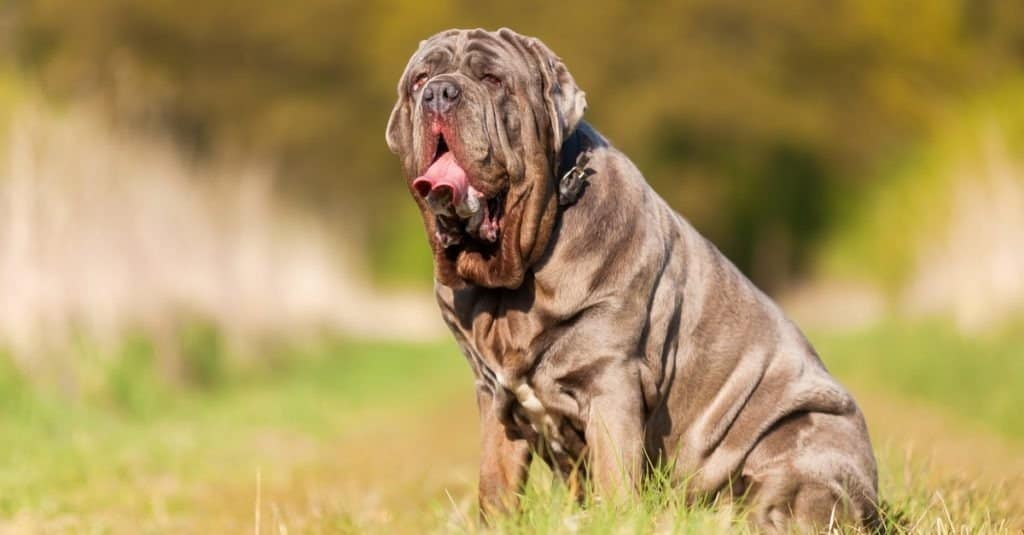
Neapolitan Mastiffs do not have many needs when it comes to exercise and a bit of room at home and a little time on a leash for a walk is good enough for them.
Health and Entertainment for your Neapolitan Mastiff
See all of our expert product reviews.
©Christian Mueller/Shutterstock.com
Size and Weight
Neapolitan Mastiff dogs are giant dogs. The females are about 24 to 29 inches in size while the males are 26 to 31 inches. Regarding their weight, females reach 120 to 175 pounds while males weigh around 150 to 200 pounds.
| Height (Male) | 24”-29” tall |
| Height (Female) | 26”-31” tall |
| Weight (male) | 120-175 lbs., fully grown |
| Weight (female) | 150-200 lbs., fully grown |
Learn more about the best big dog breeds here.
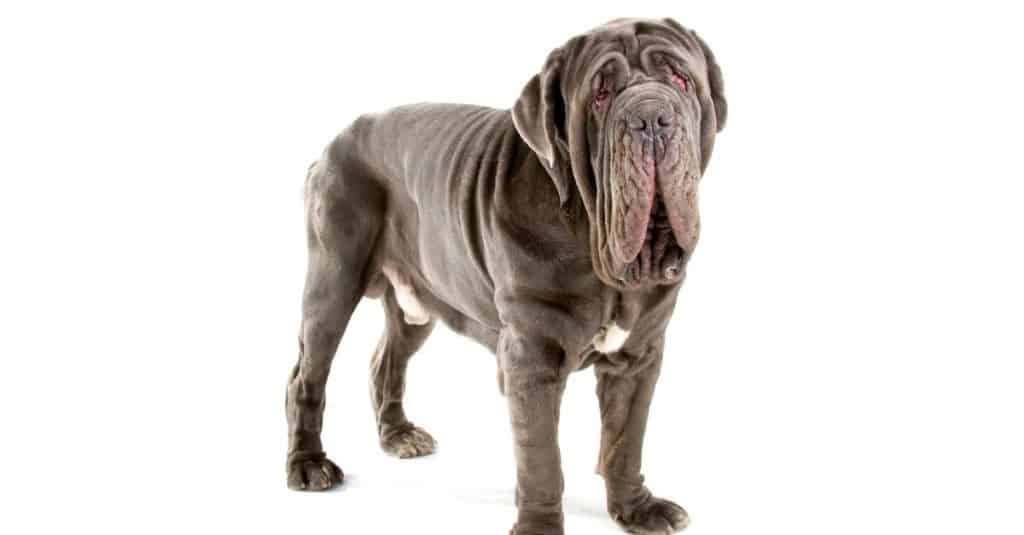
Neapolitan Mastiff males weigh around 150 to 200 pounds.
©Erik Lam/Shutterstock.com
Common Health Issues
Like many other animals, these dogs also suffer from a variety of health issues. Many of the common ailments they face are typical amongst long-legged dogs. They often face elbow and hip dysplasia, which is caused by abnormal growth and development in the socket.
Cherry eye is another concern amongst these dogs. The condition, which also impacts the tissue around their eye, can cause irritation and pain. Often, the pink tissue below the eyelid will protrude.
The eyes are a great source of health issues for these dogs – they can also suffer from entropion and progressive retinal atrophy. Entropion means that the eyelids start to roll inward, causing scratching and irritation as the eyelashes scratch the eyeball. Progressive retinal atrophy, on the other hand, causes the eyes to waste away, which can take a long time to show symptoms.
A heart condition called cardiomyopathy can occur in Neapolitan Mastiffs. This disease impacts the muscles within the heart, causing them to be rigid and enlarged. Some of these dogs suffer from autoimmune thyroiditis, preventing their body from creating the hormones from their thyroid gland.
Overall, the problems that Neapolitan Mastiff dogs are prone to include:
- Hip Dysplasia
- Elbow Dysplasia
- Cherry eye
- Entropion
- Progressive Retinal Atrophy
- Cardiomyopathy
- Autoimmune Thyroiditis
Temperament
The temperament of these dogs is both quiet and affectionate, so it should be no surprise that any threat to their owners is met with protective aggression. They won’t go out of their way to be violent, but they will do what they have to for the safety of their family.
These dogs love being around other pets and bonding well with other animals in the home. Found with breeders and animal rescues, they quickly find their place within the home amongst their housemates with a mellow demeanor. They are relatively easygoing.
Strangers don’t always feel the welcoming personality of the Neapolitan Mastiff, as the dog may be worried about threats to their family. They can also become rather aggressive towards dogs outside of their home that they are unfamiliar with.
They are very closely connected to the people they live with, struggling with separation anxiety when left alone.

The temperament of Neapolitan Mastiffs is both quiet and affectionate, so it should be no surprise that any threat to their owners is met with protective aggression.
How to Take Care of One
The first thing that you would know before you take in any pets would be how to properly take care of them. From training to food, to exercise – everything plays an important role. Here are a few things that you would need to know before you start living with a Neapolitan Mastiff:
The Best Dog Food for Them
You can offer a variety of options in your dog’s diet. Though kibble and other dry dog food are necessary to keep the teeth clean and fill the majority of their diet, some human foods are safe with the right preparation.
In particular, this dog enjoys cooked turkey and chicken, though they will also indulge in tuna on occasion. Some owners will use pasta as a way to regulate their digestive system when experiencing diarrhea.
Especially since this breed can end up with cardiomyopathy, owners should be careful to pick legume-free food. That’s because legumes in dog food have been linked to heart failure.
Therefore, A-Z Animals thinks the best dog food for Neapolitan Mastiffs is Victor Purpose – Performance, Dry Dog Food.
Not only does this food exclude questionable legume-based ingredients, but it includes all the goodness your dog needs for a happy, mobile, pain-free life. It’s high protein and gluten-free so your immense friend can build lean muscle, not excess body fat. The chondroitin and glucosamine give your Neapolitan Mastiff’s joints the support they desperately need. The taurine is good for the heart, and the amino acids and probiotics are excellent for digestion and immunity.
Here’s where you can get Victor Purpose Performance Dog Food on Chewy and Amazon.
- 81% meat protein with premium-quality beef, chicken and pork meals
- Ideal for sporting pups and those with high physical demands
- Contains glucosamine and chondroitin for long-term joint health
- Fortified with vitamins, minerals, essential fatty acids, protein and amino acids
- Promotes digestion and immune health
Maintenance and Grooming
While these dogs do not require an extensive amount of grooming, they will need regular baths to eliminate any buildup of bacteria in their folds. Most dogs don’t become very messy, only needing a bath every six to eight weeks. Bathing also eliminates extra excess hair that they’ve shed.
Between baths, make sure to wipe their wrinkles with a damp cloth. Nails should be trimmed once every few weeks, while their teeth need to be brushed as well. Many treats on the market automatically break down plaque that can accumulate, but it doesn’t replace the need to use dog-friendly toothpaste and a brush.
Since earwax can build up, it’s important to clean the ears as well.
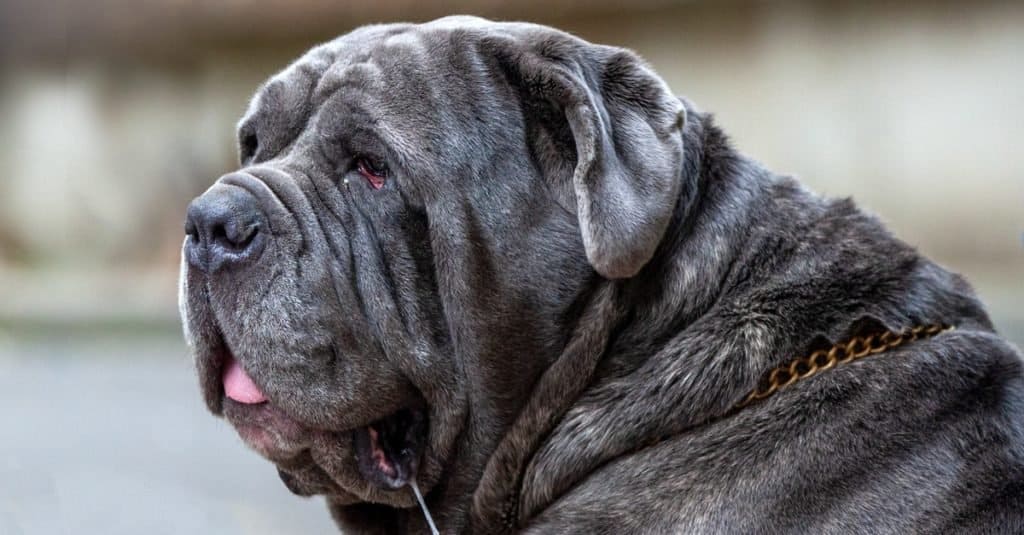
Neapolitan Mastiffs need regular baths to eliminate any buildup of bacteria in their folds.
©Sue Thatcher/Shutterstock.com
Training
While it is not very difficult to train these dogs, they can sometimes be stubborn and resistant to training if they are constantly pushed or strictly led.
Start training your puppy early on, keeping them nearby as you work to pick up a sense of motivation. Puppies have an open and pure mind, offering a foundation that is relatively responsive to commands.

Neapolitan Mastiffs can sometimes be stubborn and resistant to training if they are constantly pushed or strictly led.
©Dioniya/Shutterstock.com
Exercise
These dogs do not require a lot of exercise. The best exercise for these dogs is usually a daily walk, though they are also happy with a little extra space within the home to mosey around.
Daily walks are very important for Neapolitan Mastiff puppies, as they have much more energy.
Puppies
Neapolitan puppies are taken care of pretty much the same way as you would take care of an adult Neapolitan Mastiff dog. However, you should start training the puppy early on to help them develop good habits and get used to the usual tasks. They may be independent, but they learn quickly and enjoy pleasing their owner.
As said above, Neapolitan Mastiff puppies need regular walks to get out their energy and maintain their mental health.
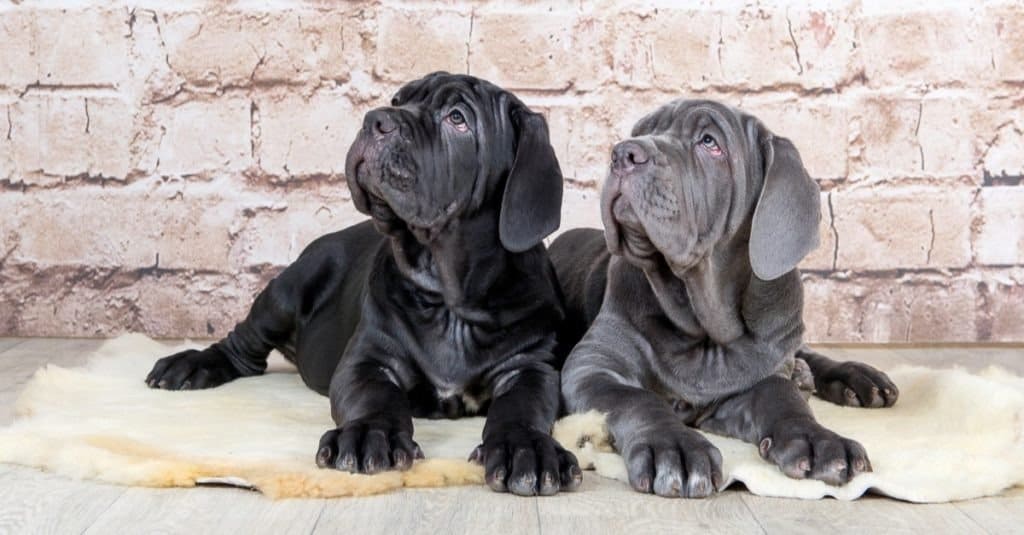
Taking care of Neapolitan Mastiff puppies is similar to taking care of adult ones.
©Fomin Serhii/Shutterstock.com
With Children
Neapolitan Mastiffs are known to be great with children like they are with the other family members – protective and affectionate. However, you’d always want to supervise a Neapolitan Mastiff around toddlers as the dog can be too large for them and can knock over the babies without intending to.
The Neapolitan Mastiffs are excellent watchdogs, and their stature makes them impressively intimidating.

With Neapolitan Mastiffs, you always want to supervise them around toddlers as they can knock them over.
©iStock.com/Okikukai
Similar Dogs
As wonderful of a dog as the Neapolitan Mastiff may be, they aren’t for everyone. Here are some dogs that are similar to the Neapolitan Mastiffs:
- American Bulldog: This one belongs to the Mastiff family but has a shorter and coarser coat. It is also known to be far more aggressive than the Neapolitan Mastiff, making it better suited to a child-free home.
- Bull Mastiff: Another from the Mastiff family, the Bull Mastiffs are known to be loyal and affectionate. Like the Neapolitan Mastiffs, they are also very protective.
- Pug: Just like the Neapolitan Mastiff dogs, these dogs also require little grooming and are prone to several health problems. They are much smaller than the Neapolitan Mastiff, making them better suited to apartments and small homes.
Popular Names
Here are some popular names for Neapolitan Mastiff dogs:
- Angel
- Bacardi
- Amer
- August
- Caesar
Neapolitan Mastiff FAQs (Frequently Asked Questions)
Are Neapolitan Mastiffs herbivores, carnivores, or omnivores?
Neapolitan Mastiffs are Omnivores, meaning they eat both plants and other animals.
What Kingdom do Neapolitan Mastiffs belong to?
Neapolitan Mastiffs belong to the Kingdom Animalia.
What class do Neapolitan Mastiffs belong to?
Neapolitan Mastiffs belong to the class Mammalia.
What phylum to Neapolitan Mastiffs belong to?
Neapolitan Mastiffs belong to the phylum Chordata.
What family do Neapolitan Mastiffs belong to?
Neapolitan Mastiffs belong to the family Canidae.
What order do Neapolitan Mastiffs belong to?
Neapolitan Mastiffs belong to the order Carnivora.
What type of covering do Neapolitan Mastiffs have?
Neapolitan Mastiffs are covered in hair.
What genus do Neapolitan Mastiffs belong to?
Neapolitan Mastiffs belong to the genus Canis.
What is an interesting fact about Neapolitan Mastiffs?
Neapolitan Mastiffs are fearless and extremely protective of their homes!
What is the scientific name for the Neapolitan Mastiff?
The scientific name for the Neapolitan Mastiff is Canis lupus.
How long does Neapolitan Mastiff live?
These dogs usually live for about 8 to 10 years.
How much does Neapolitan Mastiff cost to own?
These dogs can cost anywhere between $5,600 to $8,500 to adopt from a breeder, though the price from dog rescues is much lower. The first-year price will be around $6,900 for initial veterinary visits, sterilization, and licensing. In the years that follow, expect to spend upwards of $2,105 to keep your pup well-fed and healthy.
Is the Neapolitan Mastiff good with kids?
Yes, Neapolitan Mastiffs are great with kids. However, sometimes they can unintentionally hurt toddlers.
How much does a Neapolitan mastiff weigh?
Females weigh around 120 to 175 pounds while the males weigh around 150 to 200 pounds.
Are Neapolitan Mastiff good family dogs?
Yes, these dogs make good family dogs as they are affectionate and caring. They are also very proactive of the owner’s family.
Are Neapolitan mastiffs very aggressive?
They are not usually aggressive. They are easygoing, gentle, and affectionate. However, they can be aggressive towards strangers and unknown dogs.
Are Neapolitan mastiffs easy to train?
These dogs are not very difficult to train but don’t do well with excessive pushing and punishing.
Thank you for reading! Have some feedback for us? Contact the AZ Animals editorial team.
Sources
- Dogspot, Available here: https://www.dogspot.in/dog-breeds/neapolitan-mastiff-italian-mastiff/
- Daily Puppy, Available here: https://dogcare.dailypuppy.com/pros-cons-getting-neapolitan-mastiff-6630.html
- Dogtime, Available here: https://dogtime.com/dog-breeds/neapolitan-mastifF#/slide/1
- Vetstreet, Available here: http://www.vetstreet.com/dogs/neapolitan-mastiff#personality
- The Nest, Available here: https://pets.thenest.com/dog-food-recommendations-neapolitan-mastiff-4995.html
- Espree, Available here: https://www.espree.com/BreedProfiler/neapolitan-mastiff-grooming-bathing-and-care
- Your Pure Bred Puppy, Available here: https://www.yourpurebredpuppy.com/reviews/neapolitanmastiffs.html





